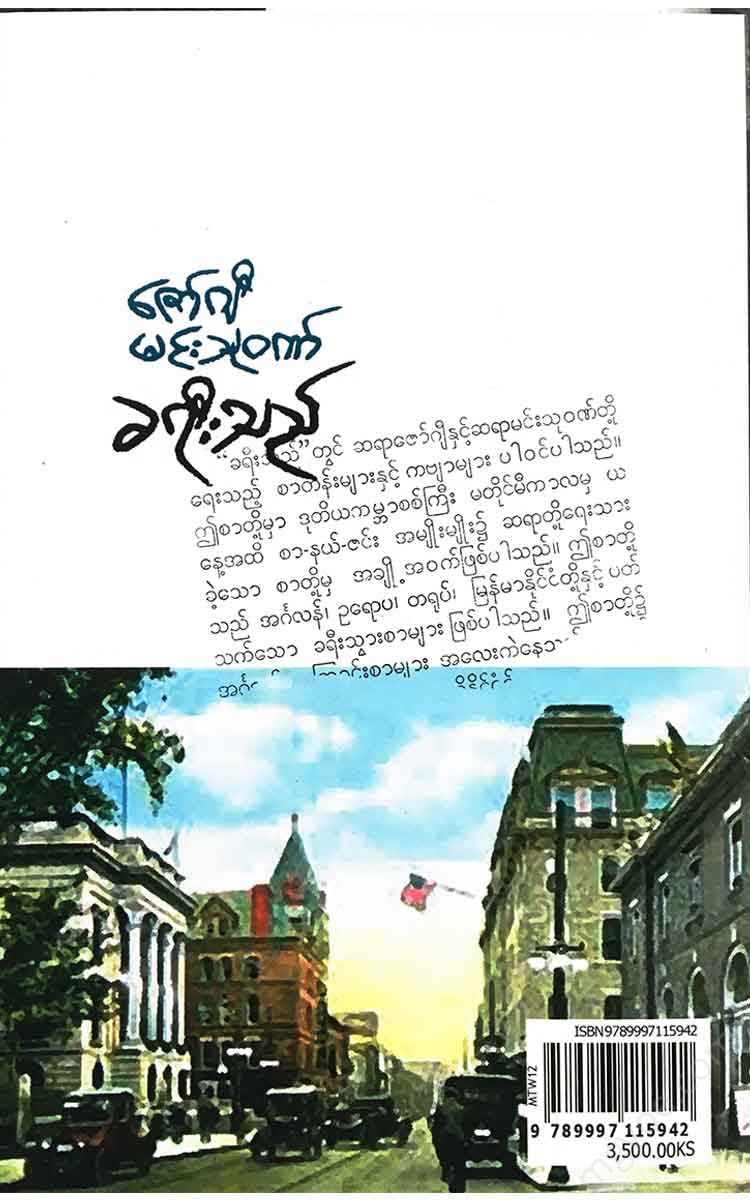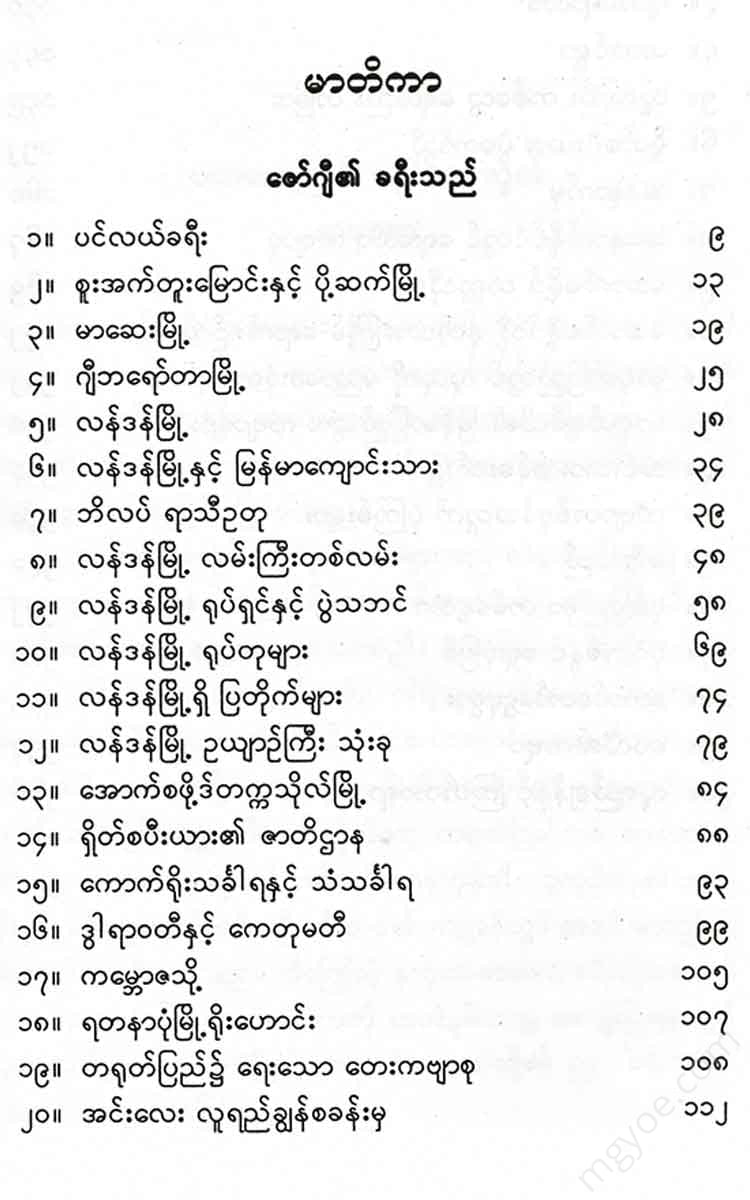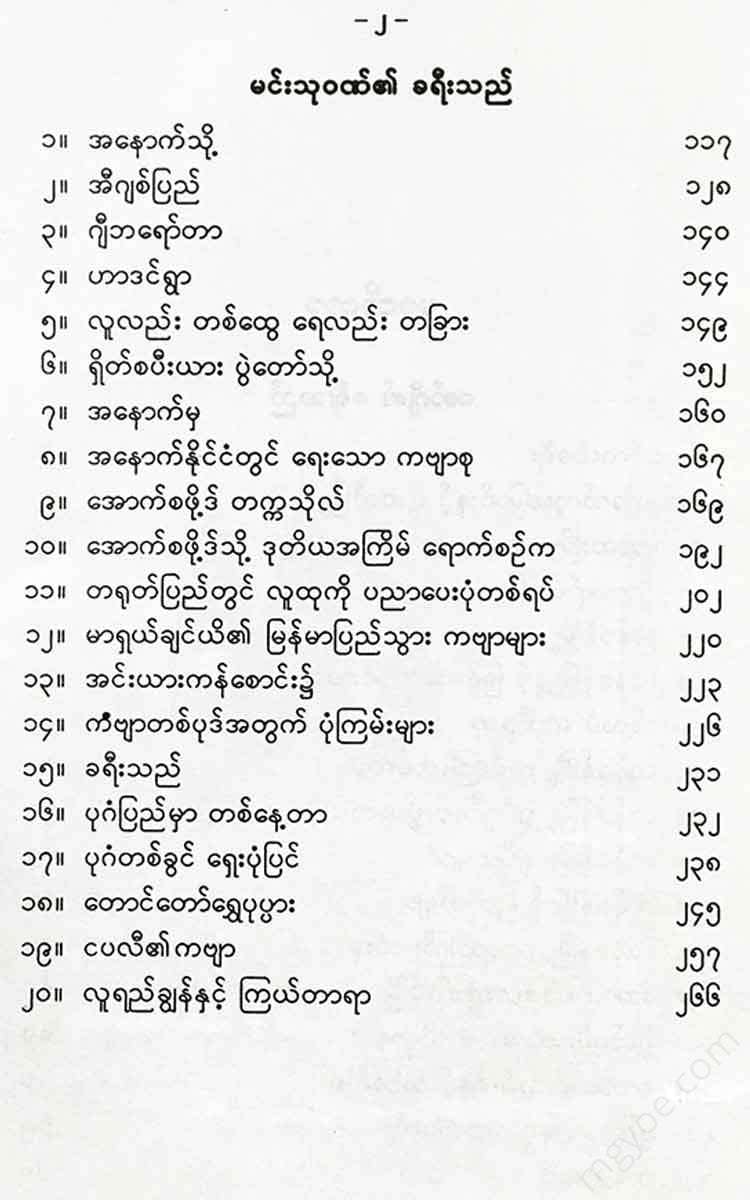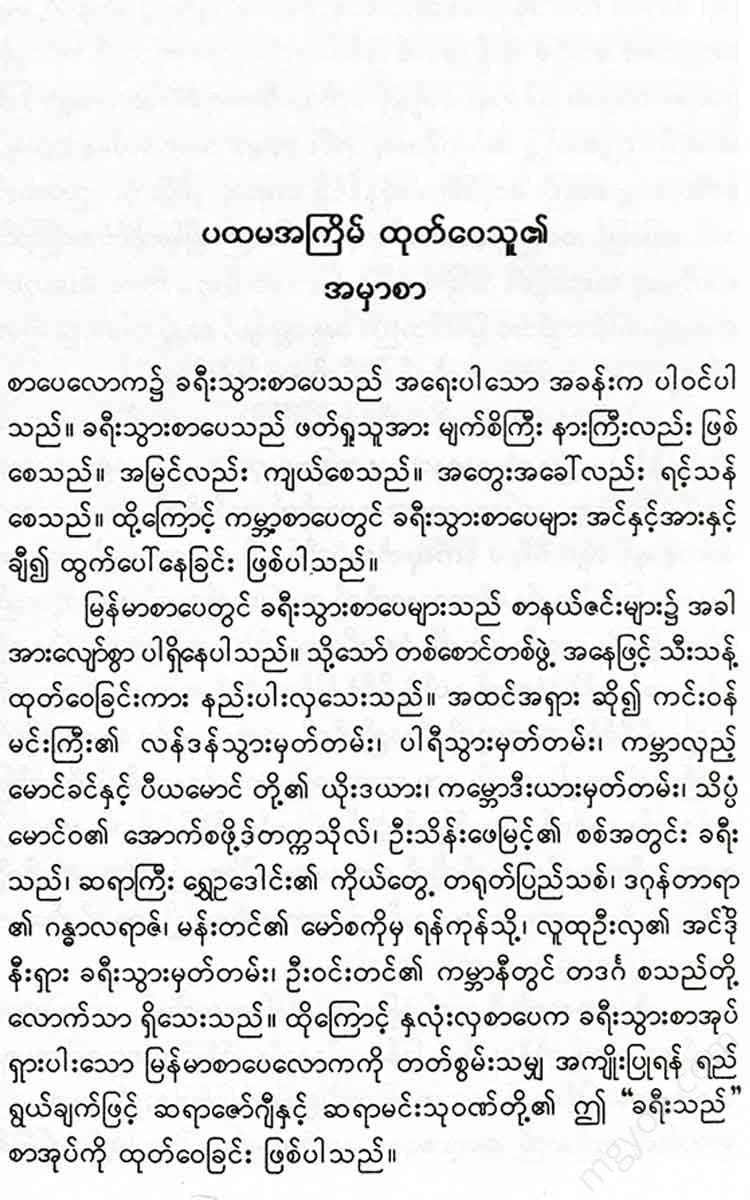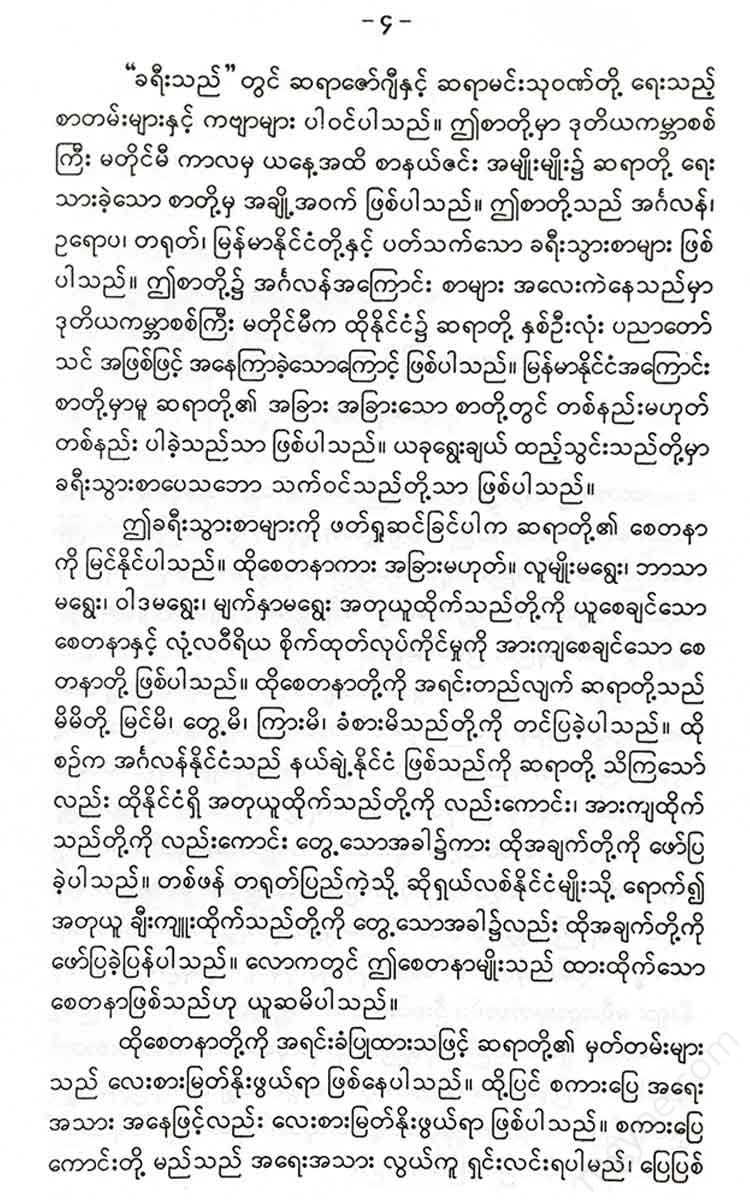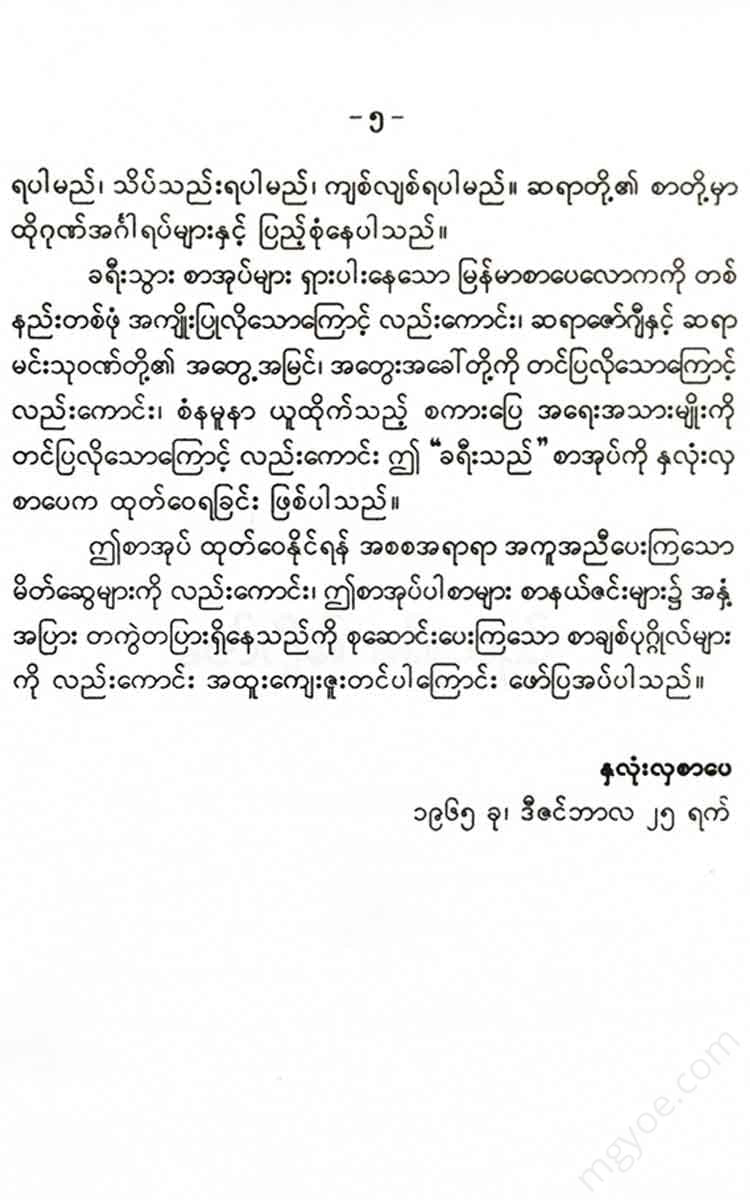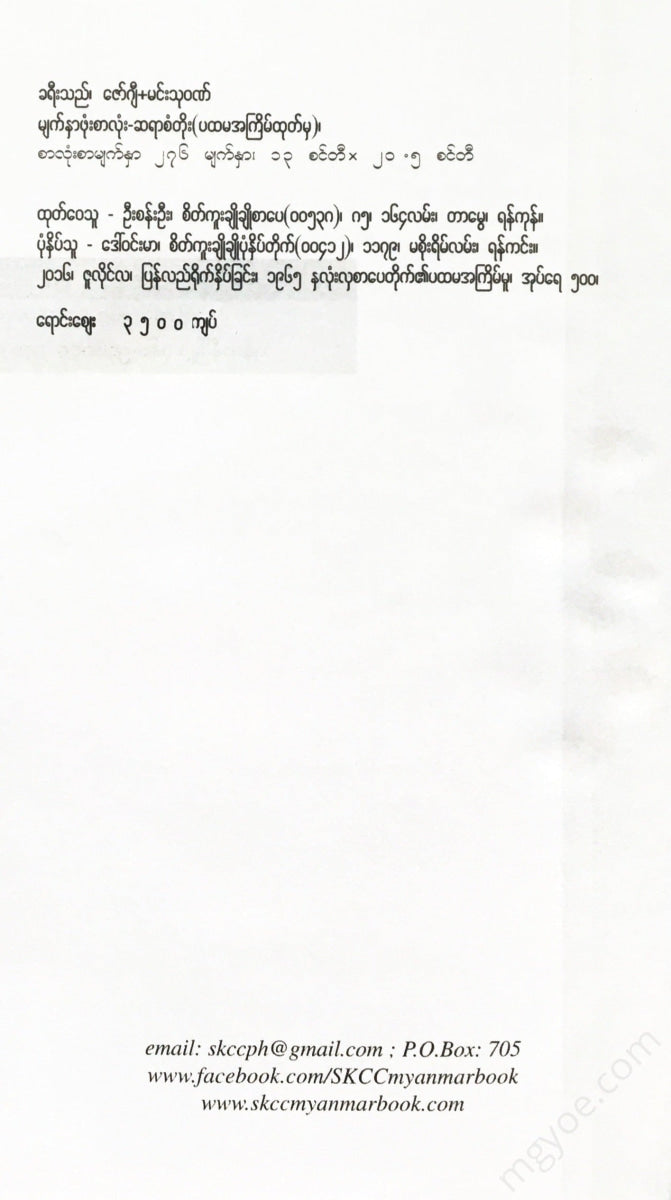စိတ်ကူးချိုချိုစာပေ
Zawgyi Min Thuwan - Traveler
Zawgyi Min Thuwan - Traveler
Couldn't load pickup availability
Sea voyage
He arrived in London on September 23, 1938, and left for Burma on August 4, 1940. He spent about two years in Britain.
When I returned to Myanmar, they asked me about the country of Burma. Some asked about the war. Some asked about the customs of Burma. Some asked about the entertainment of Burma. Some asked about the social relations of Burma. Some asked about various things. One friend even asked me about small details (both seemingly insignificant and very important) such as, “How do Burmese students live there, what do they eat?” Some also said that they were returning from Burma, and it seemed that they were very proud of the person who had returned from Burma. Then I had to say, “I am also a Burmese person.” I am also a Burmese person.
Every time I ask, I get an answer. Among those who get an answer, there are those who are satisfied. There are those who complain that they don't think they have seen everything. There are those who argue that a foreigner said that. They are right. Because I have only lived in the country for 2 years. In addition, I am a student, so my perspective is narrow. Again, even if I keep my eyes open and my ears open, there will still be thousands of things that I have not seen or heard. Again, among the things that I have seen and heard, there will still be things that I am not sure about. Again, when I give an opinion based on my perspective, there will still be some opinions that are wavering.
Therefore, I would like to warn all readers of this paper to believe only what they should believe.
If we go through the Suez Canal, it is over 8,000 miles from Myanmar to Bahrain, so the ship we were on, the "Sagaing", took about a month to travel. Along the way, we stopped at Port Sudan, Port Said, Marseille, and Gibraltar.
As soon as the “Sagaing” left the Yangon estuary, our surroundings were completely free of shores. All we could see was the blue sky above and the blue sea below. In this way, the “Sagaing” crossed the Indian Ocean, the Red Sea, the Mediterranean Sea, and the Bay of Biscay before reaching Bilop.
It would seem that a long journey at sea, without seeing any land, would be boring. It is reasonable to think so. Indeed, there are few passengers on our ship, so it is boring. However, if you live like a sailor, you will not be as bored as you think. The sailors on the ship work tirelessly during working hours and enjoy physical exercise, reading, and singing in their free time. Every day, as soon as we open our eyes, we see the sailors at work. There are those who wash the deck to keep it clean. There are those who whitewash the railings to prevent the salt water from rusting. The sailor who cleans the bedrooms goes from one room to another and cleans them. The sailor in the bathroom changes the water in the tub for each person who comes to take a bath. The cabin boy at the bow was cleaning the tables and chairs. In the stern, an old sailor was mending the sails. The mechanics were working up and down the ship, with their machines covered in dirt. The waiters were bustling from the dining room to the kitchen and from the kitchen to the dining room. The ship's doctor was checking the health of the ship. The captain was giving orders to the workers. The wire officer was always on his deck. The engineer officer was in charge of the engine room. The captain was in charge of the entire ship. All the sailors and officers he could see were working without any help.
When I saw them, I was reminded of the essay “On Sorrows” by the English writer Johnson. In his essay, the great writer gave good methods for the removal of sorrows. He said that sorrows can be relieved by entertainment and meditation, but they can only be completely removed by constant work and manual labor. He gave the sailors as an example. When I saw the sailors working like ants, I understood Johnson’s words very well. Moreover, I remembered that they were workaholics.
The sailors are not doing their job for nothing,
They had free time. In the evenings, they sometimes played with wooden balls. Sometimes they played with wooden round plates with sticks. Sometimes they played with a kind of rope called ship's 'tennis'. Also, for fun and knowledge, there was a ship's library at the bow. They used to borrow books from that library and read.
All of us passengers, apart from our work, followed the sailors' way of life. Sometimes we played with each other. Sometimes we played with the ship's officers. We also borrowed books from the ship's library. Therefore, we never got bored on the sea voyage. Far from being bored, we were never bored. Moreover, for a whole month we were constantly busy eating, playing, reading, and singing. The sea breeze was also pleasant, so even on board we seemed to be stronger than before. One day, the captain of the ship asked us to play more and more, and
Be happy, when we get to Bilap and go to school, we will have to work. Then he said, "Work hard, so that we can compete with Western students." He smiled and watched us play. He also played a few times. The captain was oblivious to what he was saying. However, as soon as we got to Bilap and went to school, we realized that what he said was very true.
Suez Canal and Port Said
If the world wants to know about Myanmar, Myanmar should first know about the world. I think that among all the things that need to be known, the Suez Canal should be included.
The Suez Canal is a world waterway that was dug through a sandy desert by human ingenuity. To the east of the canal is Asia and to the west is Africa.
To the north is the Mediterranean Sea. To the south is the Red Sea. The canal runs north-south, connecting the Mediterranean Sea and the Red Sea. It is about a hundred miles long and in some places is wide enough for two large ocean-going ships to pass through. At the mouth of the canal on the Mediterranean side is the city of Port Said, and at the mouth of the canal on the Red Sea side is the city of Suez. The canal runs through Egypt.
The ship we were on, the "Sagaing," approached Suez at about 3 p.m. As was customary, an Egyptian navigator and a doctor boarded. After a while, the "Sagaing" entered the canal.
Looking from the bow, one could see a straight, gradually narrowing canal. Looking from the stern, one could see the waves of the Red Sea crashing against the shores of the great ships bound for Asia. Looking towards Suez, one could see white buildings, green gardens, and tall oil tanks. Looking in the other direction, one could see low, sandy mountains.
The gradual entry into the canal was like a sudden transition from a noisy world to a quiet one. In the past, we had often encountered strong waves. Then the "Sagaing" had to be driven by the bow and stern. The waves crashed into the bow and jumped out of the stern. The sailors put on their raincoats and jumped and rushed to fight the incoming waves. We walked on the deck of the ship, drunk and drunk, so as not to get dizzy. Now there was no wave around the ship and it was calm. The ship was sailing smoothly. The sailors stood at the bow with folded hands, looking ahead. We looked in pairs, in pairs, in pairs, looking for something that pleased our eyes.
On the bank of the canal, not far away, four or five camels were seen walking slowly in a row with their long legs. A young Arab camel, who was riding on the back of the camel, waved to us. We responded. If he remembered us as a ship and a beauty, we were ready to say to him as a camel and a beauty.
The "Sagaing" was sailing gently. Sometimes it passed a small boat belonging to the canal workers. Once, the ship was hit by waves and passed a small sand-digger near a broken shore. In this way, the sun set on its journey.
The Suez Canal is a marvel. It is also the brainchild of European political geniuses. It is also the lifeblood of world trade. In other words, the Suez Canal is a world witness to the imagination, political cunning, and trading skills of Europeans. This is how it looks like. When the canal was built, it was between 1850 and 1870. Before that, even the most daring Europeans believed that the idea of digging a canal was a bad idea, a bad idea. The Frenchman Ferdinand de Lachaise attacked this idea with unwavering energy, humility, and a rich imagination.
The most important difficulty of the company was to obtain land from the governor of Egypt and to obtain money for the excavation. At first, the governor of Egypt did not agree to the construction of a canal in his territory. However, when his son, "Sepsia", succeeded him as governor, he was allowed to dig the canal. Once again, he needed money to dig. The company returned to Europe and formed a company. When sufficient funds were available, the business was successful within twenty years of its inception.
This is how the European political elites were fed. The Suez Canal was located at the crossroads of Europe, Africa, and Asia. When the British government was trying to raise money to build the canal, it was opposed. It was because it thought that the canal would be controlled by the French. Later, when the British government realized the usefulness of the canal, it bought a large amount of money from the Egyptian government. It was said that the Suez Canal was like a “key” to the European-dominated Asian countries, and could change the future of Europe and Asia.
It is the lifeblood of world trade because it is a short, time-saving, cost-effective and wide-ranging route. Before the canal, ships from Europe to Asia had to go around Africa. Now they go through the Suez Canal. If you go around Africa from London to Calcutta, it is 11,686 miles. If you go through Suez, it is only 8,049 miles.
The "Sagaing" spent the night in the canal. At dawn, it reached Portsat. Even as it arrived, the white buildings of the Suez Canal Company were clearly visible.
Port Said is a city owned by the Egyptian government. It was named after the Egyptian ruler Mahamsed, who authorized the construction of the canal. It is a port city where ships from all over the world come and go, so it can be said to be a city of many people. Because many people often stop there, there is a mixture of good and bad customs from all over the world. However, the city of the Orientals is still oriental. Because as soon as the ship docks, we see the unruly behavior of the oriental merchants.
They rush onto the ship and sell their goods, clinging to their backs. They sell them with a loud voice. They hustle and bustle among themselves and sell them. They sell them secretly. They sell them openly. It is very unpleasant. And there is also the fear of pickpockets.
I was just looking to buy a small leather bag, but the bag seller asked me for money because I was too much. The vendor who was selling it in secret suddenly showed me a dirty toy car as an example, and the vendor looked at me with angry eyes and couldn't chew. Was it because I was too much? The vendor said to me, "Have you ever seen such a thing?" and went away because I was too much. In this case, I dare to say that I am not too much. Because

